Written by Alexis Barnes, M.S. Graduate Research Assistant in the Dept. of Agronomy, Horticulture, and Plant Science, under the direction and review of Kristine Lang and Rhoda Burrows, former Professor & SDSU Extension Horticulture Specialist.
Introduction
Vegetable farmers struggle with weed suppression and soil fertility management, which increases the use of black plastic mulch and can add to an unsustainable waste stream. Perennial legume cover crops provide nutrients to soil prior to vegetable planting and may overwinter to establish living mulches for future growing seasons. During the growing season, clover cover crops that are grown as living mulch may suppress weeds, contribute nitrogen after establishment, and prevent soil erosion. However, some previous research has shown that using clover as a living mulch or living pathway between planting rows can compete with cash crops and result in lower vegetable yields.
Materials and Methods
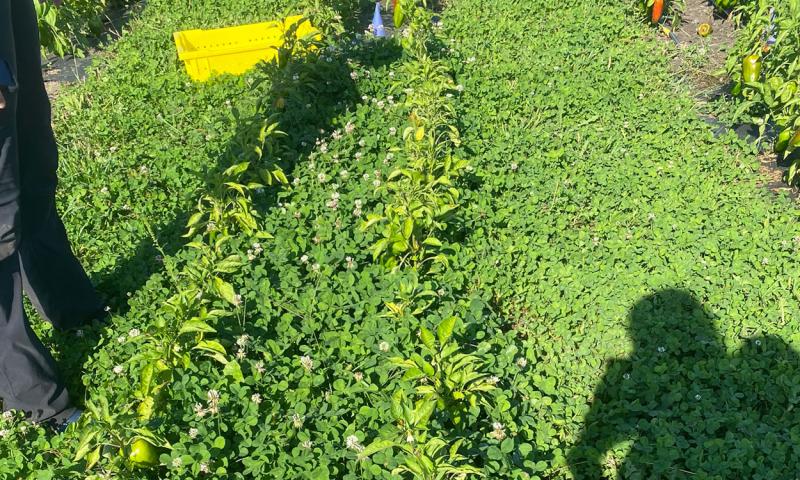
Field research was conducted over the summer months in 2022 at the Specialty Crop Research Field in Brookings, South Dakota. The objective of this research was to understand the relationship between three different clover species used in a pepper production system. The cash crop was a ‘Red Knight’ Pepper (Capsicum anuum), which was chosen for its compact habit and strong performance in prior Midwest studies. Clover cultivars trialed include ‘Domino’ White clover (Trifolium repens), ‘Aberlasting’ White x Kura clover (T. repens x ambiguum), and ‘Dynamite’ Red clover (T. pratense). A fourth treatment of a bare ground control was also used.
Plot and Treatment Design
The clovers were whole plots that were planted in a split plot design with four blocked replications. Within each whole plot of clover, four soil management treatments (subplots) were randomized. The management treatments were: No-till + fabric (abbreviated as NTF), no-till without fabric (abbreviated as NT), tilled + fabric (abbreviated as TF) and tilled without fabric (abbreviated as T). The management treatments are further detailed below. These two treatment factors were used to understand the effects of clover species in combination with various in-row management practices.

Clover Planting
Clover was seeded on April 26 at the Specialty Crop Research Field using a 5-foot no-till drill pulled by a tractor. Clover whole plots were 12 feet wide by 25 feet long. ‘Aberlasting’ White x Kura clover was seeded at 11.93 pounds per acre (abbreviated as lbs./A), ‘Dynamite’ Red clover was seeded at 12.26 lbs./A, and ‘Domino’ White clover was seeded at 7.60 lbs./A. Oats were seeded at 35 lbs./A simultaneously with the clover to act as a nurse crop while clover seedlings established. Clover rates were based on recommendations from the Midwest Cover Crops Council, the Sustainable Agriculture Research and Education program, and the seed provider, GO Seed.
Clover plots were mowed on June 1 prior to pepper planting. Initial tillage events prior to vegetable planting were necessary for tilled fabric and tilled no-fabric treatments. On June 1, management strips were tilled with two passes with a BCS walk-behind tiller (30-inch) to a depth of approximately 6 inches. Black woven landscape fabric was 36 inches wide and had planting holes that had been cauterized with a butane burner prior to installation. All management rows were 12 feet long.
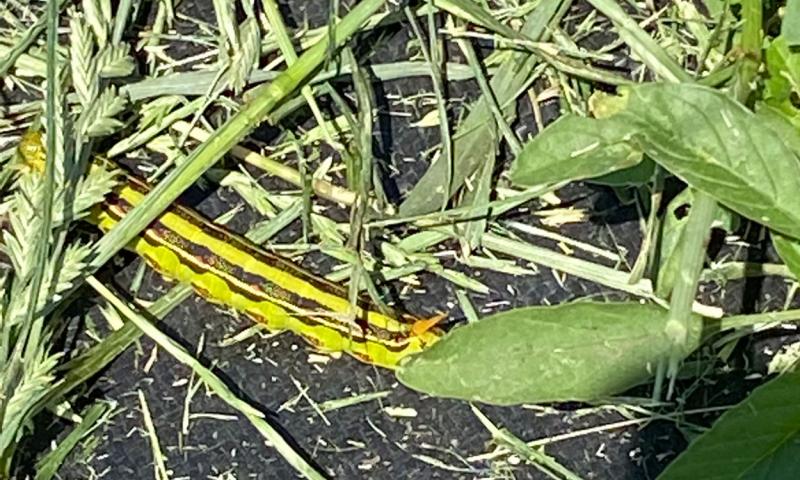
Pepper Planting
Peppers were seeded in a greenhouse on the SDSU campus on April 5. Peppers were fertigated in the greenhouse at 250 parts per million (abbreviated as ppm) nitrogen (abbreviated as N) on May 8, May 20, and May 25 (10-4-3 Natures Source Organic Plant Food). On May 10 a higher rate at of 300 ppm N was used. Peppers were moved outside to harden off on May 27. On June 3, peppers were transplanted into the Specialty Crop Research Field in Brookings, South Dakota. Twenty pepper plants per plot were hand planted in staggered, double rows 18 inches apart from each other with 12 inches between plants within row. The time required to transplant peppers was recorded in two out of the four research blocks to give an understanding of the labor needed for planting in each of the four management systems.
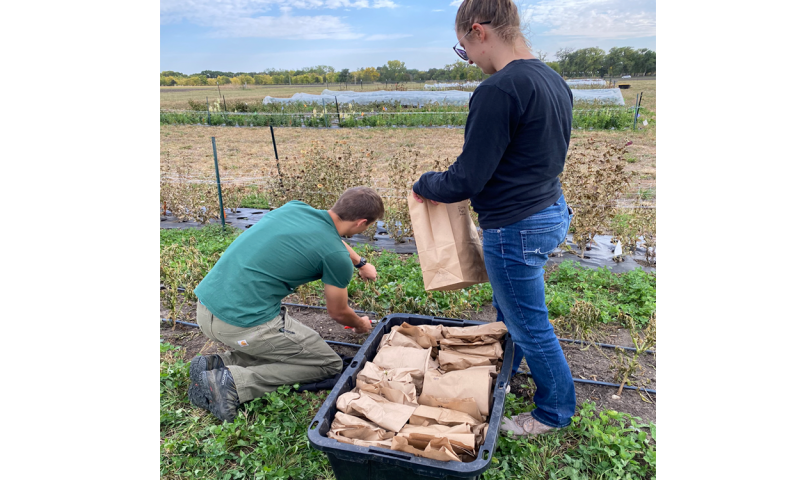
Plot Management
A double row of drip tape was installed prior to pepper planting approximately 16 inches apart, with an emitter spacing of 8 inches and a flow rate of 0.20 gallons per hour (abbreviated as gph) @ 8 pounds per square inch (abbreviated as psi). Six hours of initial watering was applied for root establishment, and three hours a week on average when rain did not occur. The pepper crop was fertilized seven times: on June 3, June 11, June 17, July 1, August 3, August 15, and August 31 with a Dosatron fertilizer injector set to apply N at 250 ppm for an average of three hours for each watering event.
Chlorophyll content was measured on July 29, using a SPAD meter to get an indirect measurement of leaf chlorophyll concentration. Pepper canopy (width) was measured on July 29 using a tape measure placed parallel to the ground to measure from opposite leaf tips. Plant height was measured the same day from the soil to the growing point of each plant. Eight plants per plot were measured for SPAD, canopy, and height. Only height was measured on September 29 due to early-season frost that severely wilted pepper foliage.
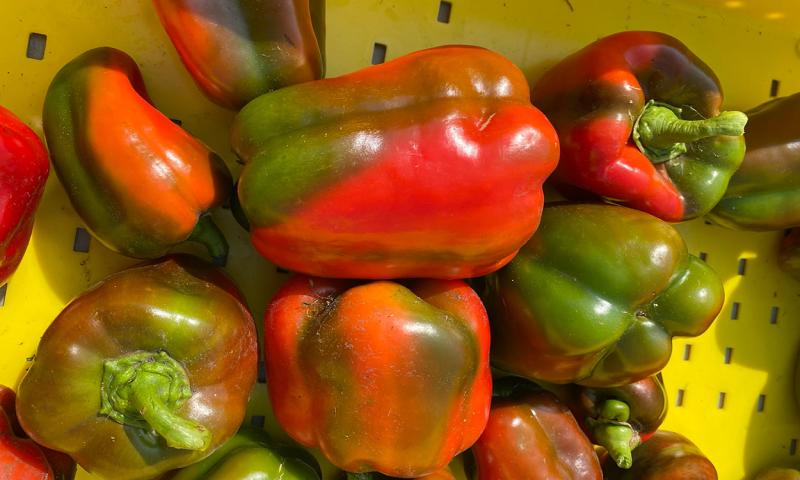
Performance Assessment
Clover performance was assessed six times over the course of the growing season on June 15, June 30, July 13, August 8, August 22, and September 30. A 25 x 25-centimeter quadrat was randomly tossed three times within each clover whole plot pathway (between crop rows) and two times in each in-row clover x management subplot (within planting row) to analyze the relationship between weeds and clover species. The tallest clover, weed and oat in each quadrat were measured from the base of the stem to the tallest leaf point. All oats, clovers and weeds present in the quadrat were cut at the base of the stem and kept in a brown paper sample bag for biomass drying. Samples were then dried for approximately three days at 140 degrees Fahrenheit. Dried samples were weighed to the nearest 0.1 grams to determine plant biomass. After data was collected, clover and weeds were mowed in the three clover species whole plots and hand cultivated in the bare ground treatments; time spent for these events was recorded. Timed weeding events occurred for in-row (subplot) weed management treatments and consisted of hand pulling and using a stirrup hoe when appropriate. Mowing height was set at 3 inches from the ground using a walk-behind mulching mower. Mowing and cultivation occurred after each cover crop/weed biomass assessment, but two mowing and hand cultivation events occurred on August 22 and September 7, without data collection due to time constraints.
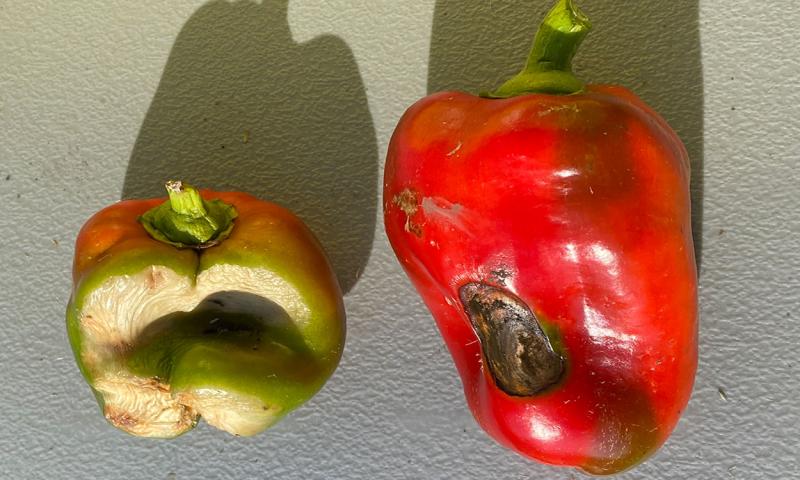
Four pepper harvest events occurred, on August 7, September 1, September 14, and September 26. During the first three harvests, only fruit that were at least 80% red in color were harvested. At the fourth and final harvest on September 26, all fruit, regardless of size and color, were harvested. Fruit was counted, weighed, and graded into different categories based on the U.S. Department of Agriculture (abbreviated as USDA) quality and size standards. Marketable categories include U.S. Fancy, (free of imperfections and a height of 3 ½ inches and diameter of 3 inches and above). U.S. 1, (free of imperfections and a height of 3 inches and diameter of 2 ½ inches). U.S. 2, (free of imperfections and a height and diameter of 2 inches and below). Non-marketable categories include sunscald fruit damaged by sun exposure and/or excessive heat.
At the end of the season, on September 30, pepper plant biomass was collected after harvest to determine whole plant mass. Four pepper plants in each subplot were trimmed at the base of the stem and dried for three days at 140 degrees Fahrenheit. Dried pepper biomass was weighed to the nearest 0.5 grams. All data was analyzed using PROC GLIMMIX of SAS with clover and management treatments as fixed effects and block as a random effect.
Results and Discussion
Clover whole plot (pathway) height and biomass accumulation.
Oat and clover height and biomass differed significantly between clover treatments and bare ground on July 13 (see Appendix A, Table 1). Oat and clover biomass was relatively the same for all three clover treatments. There were no differences in weed height or biomass early in the season.
Clover heights differed significantly on September 26, with red clover growing the tallest height compared to the other clover treatments (see Appendix A, Table 2). It was interesting that average weed height was significant, but weed biomass was not significant. This may have been due to high variability among replicates.
In-row oat, clover, and weed height and biomass accumulation.
Clover and oat height and biomass differed significantly between treatments on July 13 (see Appendix A, Table 3). Not surprisingly, T and TF resulted in not oat or clover biomass to be collected as compared to the NT and NTF management treatments. In-row weed height and biomass were not affected by management, regardless of the clover treatment.
Clover height and biomass differed significantly among management treatments on September 26 (see Appendix A, Table 4). Average clover height and biomass was highest within NT plots followed by NTF plots, where clover could be recovered from within planting holes in the fabric. Average weed height and weight was not significant in any of the clover treatments.
Yield
Bare ground treatments resulted in significantly higher pepper yields in all marketable categories as compared to the three clover species (see Appendix A, Table 5)., The highest volume of peppers was within the U.S. 2 category, indicating smaller fruit overall. Management strategies only affected the count of U.S. Fancy and U.S. 1 peppers with the NT treatment decreasing the number of marketable fruits collected. Interestingly, the number of fruits with sunscald was unaffected by the clover or in-row soil management treatments.
Conclusion
Year one results indicate that pepper yield was negatively impacted using living mulch, regardless of clover species or in-row management strategies. Year one results also show that bare ground treatments produced the highest yield of marketable peppers. White and white x kura clover performed relatively the same and were slower to establish compared to the red clover. It is important to remember that this is only one year of data, and our results underscore potential challenges for living mulch and cash crop competition during the clover establishment year. Benefits and challenges may be different when planting into a second-year clover cover crop. Adjustments to irrigation and fertilizer management in 2023 will be made to better optimize the living mulch system.
Looking ahead to the 2023 season, some added procedures to research are soil arthropod data collection, improved pest scouting, and more extensive identification of which weeds are problematic. Farmers who are interested in living mulches should consider their soil health goals, planting and cover crop management equipment, and their ability to accept a potential yield loss.
Acknowledgments
Special thanks to the USDA Specialty Crop Block Grant Program administered by the South Dakota Department of Agriculture and Natural Resources for funding this research and associated outreach. Many thanks to the SDSU Undergraduate Research Assistants, Jacob Koch, Ellen Fitzpatrick and Anne Knofczynski for field season and data collection support. Thank you to the SDSU Department of Agronomy, Horticulture and Plant Science for allocating land for this project and their continued support.
Additional Resources
References
- Bruce D, Silva EM and Dawson JC (2022) Suppression of weed and insect populations by living cover crop mulches in organic squash production. Front. Sustain. Food Syst. 6:995224. doi: 10.3389/fsufs.2022.995224
- Lang, K. M., Nair, A., & Moore, K. J. (2020). Cultivar Selection and Placement of Shadecloth on Midwest High Tunnels Affects Colored Bell Pepper Yield, Fruit Quality, and Plant Growth, HortScience horts, 55(4), 550-559. Retrieved Mar 27, 2023.
- Pfeiffer, A., Silva, E., & Colquhoun, J. (2016). Living mulch cover crops for weed control in small-scale applications. Renewable Agriculture and Food Systems, 31(4), 309-317. doi:10.1017/S1742170515000253Puka-Beals, J., & Gramig, G. (2021). Weed Suppression Potential of Living Mulches, Newspaper Hydromulches, and Compost Blankets in Organically Managed Carrot Production, HortTechnology hortte, 31(1), 89-96. Retrieved Mar 27, 2023.
- Tarrant, A. R., Brainard, D. C., & Hayden, Z. D. (2020). Cover Crop Performance between Plastic-mulched Beds: Impacts on Weeds and Soil Resources, HortScience horts, 55(7), 1069-1077. Retrieved Mar 27, 2023.
- Sweet Peppers Grades and Standards, USDA Agriculture Marketing Service.
Suggested Content
Appendix A
Results and Discussion Tables
|
|
|
|||||
|---|---|---|---|---|---|---|
| Clover Treatment |
|
|
|
|
|
|
| Bare Ground |
|
|
|
|
|
|
| Red |
|
|
|
|
|
|
| White |
|
|
|
|
|
|
| White x Kura |
|
|
|
|
|
|
w Values within the same column and treatment followed by the same letter are not statistically different according to Fisher’s protected least significant difference (P ≤ 0.05). Data are presented as management (M) within clover (C) treatments due to multiple response variables with M x C interactions.
z Planting rows were 18 inches wide and each plot was planted with twenty 'Red Knight' peppers spaced one foot apart and 18 inches between double rows.
|
|
|
|||
| Clover Treatment |
|
|
|
|
| Bare Ground |
|
|
|
|
| Red |
|
|
|
|
| White |
|
|
|
|
| White x Kura |
|
|
|
|
w Values within the same column and treatment followed by the same letter are not statistically different according to Fisher’s protected least significant difference (P ≤ 0.05). Data are presented as management (M) within clover (C) treatments due to multiple response variables with M x C interactions.
z Planting rows were 18 inches wide and each plot was planted with twenty 'Red Knight' peppers spaced one foot apart and 18 inches between double rows.
| Clover Treatment |
|
|
||||
|---|---|---|---|---|---|---|
| Bare Ground |
|
|
|
|
|
|
| Ty |
|
|
|
|
|
|
| NT |
|
|
|
|
|
|
| TF |
|
|
|
|
|
|
| NTF |
|
|
|
|
|
|
| Red Clover |
|
|
|
|
|
|
| T |
|
|
|
|
|
|
| NT |
|
|
|
|
|
|
| TF |
|
|
|
|
|
|
| NTF |
|
|
|
|
|
|
| White Clover |
|
|
|
|
|
|
| T |
|
|
|
|
|
|
| NT |
|
|
|
|
|
|
| TF |
|
|
|
|
|
|
| NTF |
|
|
|
|
|
|
| White x Kura Clover |
|
|
|
|
|
|
| T |
|
|
|
|
|
|
| NT |
|
|
|
|
|
|
| TF |
|
|
|
|
|
|
| NTF |
|
|
|
|
|
|
w Values within the same column and treatment followed by the same letter are not statistically different according to Fisher’s protected least significant difference (P ≤ 0.05). Data are presented as management (M) within clover (C) treatments due to multiple response variables with M x C interactions.
y Management treatments were tillage (T), no-till (NT), tillage + fabric (TF), and no-till + fabric (NTF).
z Planting rows were 18 inches wide and each plot was planted with twenty 'Red Knight' peppers spaced one foot apart and 18 inches between double rows.
| Clover Treatment |
|
|
||
|---|---|---|---|---|
| Bare Ground |
|
|
|
|
| Ty |
|
|
|
|
| NT |
|
|
|
|
| TF |
|
|
|
|
| NTF |
|
|
|
|
| Red Clover |
|
|
|
|
| T |
|
|
|
|
| NT |
|
|
|
|
| TF |
|
|
|
|
| NTF |
|
|
|
|
| White Clover |
|
|
|
|
| T |
|
|
|
|
| NT |
|
|
|
|
| TF |
|
|
|
|
| NTF |
|
|
|
|
| White x Kura Clover |
|
|
|
|
| T |
|
|
|
|
| NT |
|
|
|
|
| TF |
|
|
|
|
| NTF |
|
|
|
|
w Values within the same column and treatment followed by the same letter are not statistically different according to Fisher’s protected least significant difference (P ≤ 0.05). Data are presented as management (M) within clover (C) treatments due to multiple response variables with M x C interactions.
y Management treatments were tillage (T), no-till (NT), tillage + fabric (TF), and no-till + fabric (NTF).
z Planting rows were 18 inches wide and each plot was planted with twenty 'Red Knight' peppers spaced one foot apart and 18 inches between the double rows.
| Treatment |
|
|||||||
|---|---|---|---|---|---|---|---|---|
| Clover (C)z |
Ct. |
(lbs.) |
Ct. |
(lbs.) |
Ct. |
(lbs.) |
Ct. |
(lbs.) |
| BG |
|
|
|
|
|
|
|
|
| RC |
|
|
|
|
|
|
|
|
| WC |
|
|
|
|
|
|
|
|
| KC |
|
|
|
|
|
|
|
|
| p-valuex |
|
|
|
|
|
|
|
|
| Management (M)w |
Ct. |
(lbs.) |
Ct. |
(lbs.) |
Ct. |
(lbs.) |
Ct. |
(lbs.) |
| T |
|
|
|
|
|
|
|
|
| NT |
|
|
|
|
|
|
|
|
| TF |
|
|
|
|
|
|
|
|
| NTF |
|
|
|
|
|
|
|
|
| p-value |
|
|
|
|
|
|
|
|
| C x M |
Ct. |
(lbs.) |
Ct. |
(lbs.) |
Ct. |
(lbs.) |
Ct. |
(lbs.) |
| p-value |
|
|
|
|
|
|
|
|
w Management treatments were tillage (T), no-till (NT), tillage + fabric (TF), and no-till + fabric (NTF)
x p-values based on F test.
y Values within the same column and treatment followed by the same letter are not statistically different according to Fisher’s protected least significant difference (P ≤ 0.05).
z Clover treatments were: bare ground (BG), red clover (RC), white clover, (WC), and white x kura clover (KC)

